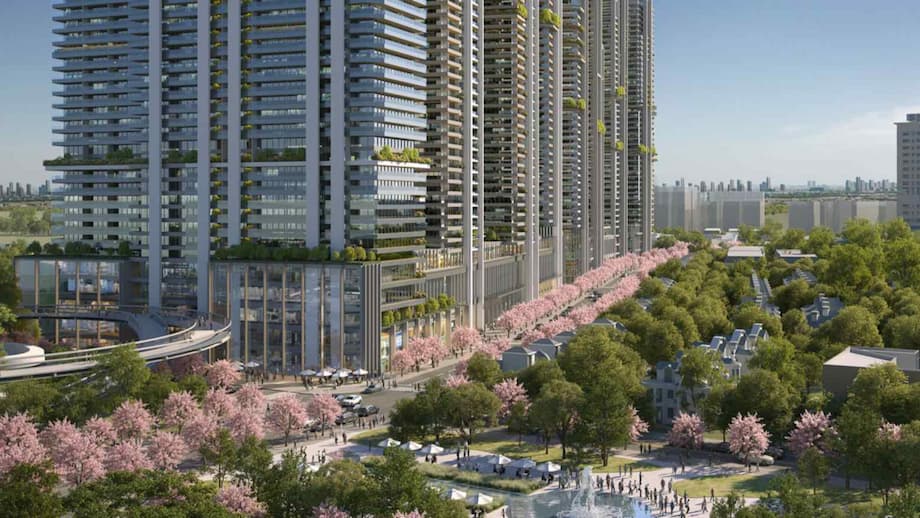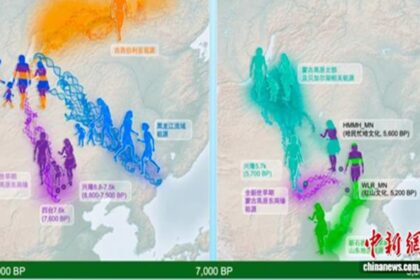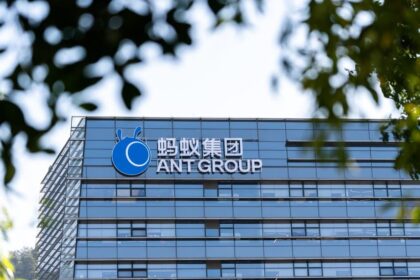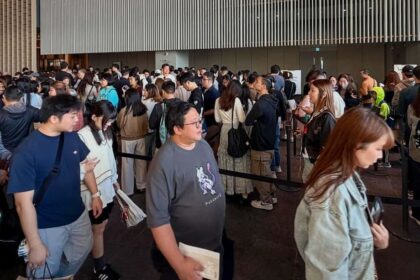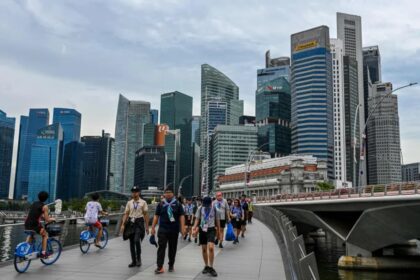Vietnam’s North Hanoi Smart City: A Visionary Urban Transformation Takes Shape
Vietnam’s capital is witnessing the dawn of a transformative era as work begins on the $4.2 billion North Hanoi Smart City project. Backed by Japan’s Sumitomo Corporation and Vietnam’s BRG Group, this ambitious development aims to redefine urban living in Southeast Asia, blending cutting-edge technology, sustainability, and international cooperation. After years of planning and delays, the project is now advancing, promising to become a new symbol of Vietnam-Japan partnership and a model for future cities in the region.
- Vietnam’s North Hanoi Smart City: A Visionary Urban Transformation Takes Shape
- What Is the North Hanoi Smart City Project?
- Smart City Technologies and Sustainable Urban Planning
- The 108-Story Financial Tower: A New Landmark for Vietnam
- Socio-Economic Impact and Symbolism
- Challenges and Progress: Navigating Complexities
- Broader Implications: Setting a New Standard for Urbanization
- In Summary
What Is the North Hanoi Smart City Project?
The North Hanoi Smart City is a massive urban development covering 272 hectares (about the size of five Tokyo Disneylands) in Dong Anh district, just north of Hanoi’s city center. The project is strategically located at the foot of the Nhat Tan Bridge, connecting downtown Hanoi with Noi Bai International Airport, and is bordered by major transport arteries like the Thang Long and Long Bien bridges. This location is not only logistically advantageous but also positions the smart city as a gateway between the capital and the world.
The project is being developed in five phases over nine years, with completion targeted for 2032. The first four phases focus on essential infrastructure—residential buildings, schools, hospitals, green spaces, and commercial areas—while the final phase will see the construction of the project’s centerpiece: a 108-story financial tower, set to become the tallest building in Vietnam and one of the highest in Southeast Asia.
Consortium and International Collaboration
The North Hanoi Smart City is spearheaded by the North Hanoi Smart City Development Investment JSC, a joint venture between Vietnam’s BRG Group and Japan’s Sumitomo Corporation. Sumitomo has assembled a consortium of six Japanese companies, including NTT Communications, TEPCO Power Grid, NEC Corporation, Hakuhodo, and Mitsubishi Heavy Industries Engineering, to bring advanced technologies and expertise to the project. This collaboration aims to address Hanoi’s pressing urban challenges—traffic congestion, energy management, education, healthcare, and environmental sustainability—while fostering economic growth and community enrichment.
Phased Development and Key Features
The project’s five phases are meticulously planned:
- Phase 1: 72.7 hectares—initial residential and public amenities
- Phase 2: 67.5 hectares—expansion of housing, schools, and green spaces
- Phase 3: 65.7 hectares—further infrastructure and community facilities
- Phase 4: 30.2 hectares—additional commercial and recreational developments
- Phase 5: 35.3 hectares—construction of the 108-story Financial Tower and a major shopping mall
By 2025, the city aims to accommodate around 30,000 residents, with the population expected to grow as the project matures.
Smart City Technologies and Sustainable Urban Planning
At the heart of the North Hanoi Smart City is a commitment to smart, sustainable urbanism. The project leverages Japanese expertise in digital infrastructure, energy management, and community services to create a city that is not only technologically advanced but also environmentally responsible and socially inclusive.
Zero-Emission and Carbon-Neutral Ambitions
One of the project’s most ambitious goals is to become Vietnam’s first carbon-neutral urban area. At the Asia Zero Emission Community (AZEC) Leaders Meeting, BRG Group, Sumitomo Corporation, and other partners signed a memorandum of understanding to decarbonize the smart city and the adjacent Thang Long Industrial Park. The plan includes:
- Deploying renewable energy sources such as solar and biomass to cover 30–40% of the city’s electricity needs
- Implementing energy-saving solutions and sustainable energy cycles
- Utilizing carbon credits to offset remaining emissions
Sumitomo aims to achieve carbon neutrality at all its sites by 2030, aligning with Vietnam’s national goal of net-zero emissions by 2050. Nguyen Thi Nga, chair of BRG Group, emphasized the project’s role as a model for sustainable urban development in Vietnam and the broader ASEAN region.
Smart Infrastructure and Digital Services
The city’s infrastructure is designed to integrate advanced technologies for mobility, security, energy management, healthcare, and disaster prevention. Residents will benefit from application-based services that enhance safety, convenience, and community engagement. The open platform approach is intended to attract startups and established companies, fostering innovation and economic dynamism within the city.
Sumitomo’s consortium partners bring expertise in telecommunications, power grids, IT, and engineering, ensuring that the city’s backbone is robust and future-proof. The goal is to create a living environment that is both comfortable and resilient, with green spaces, waterways, and public amenities woven into the urban fabric.
The 108-Story Financial Tower: A New Landmark for Vietnam
The most iconic feature of the North Hanoi Smart City will be the 108-story Financial Tower, designed by the renowned global architecture firm Skidmore, Owings & Merrill (SOM). Selected through an international design competition, the tower is envisioned as a mixed-use skyscraper surrounded by a vast public park. It will serve as a landmark and a gateway, marking the city’s skyline and acting as a hub of activity for thousands of people each day.
The design draws inspiration from Vietnamese culture and nature, incorporating patterns and forms found in native plants and traditional architecture. The tower will feature passive strategies for natural ventilation, sky gardens hundreds of feet above ground, and wind turbines to generate renewable power. Two independent structures are connected by a vertical bridge, creating communal spaces and maximizing access to natural light and air.
Once completed, the Financial Tower will not only be the tallest building in Vietnam but also a symbol of the country’s aspirations for modernity, sustainability, and international cooperation.
Socio-Economic Impact and Symbolism
The North Hanoi Smart City is more than just a real estate development—it is a statement of Vietnam’s economic ambitions and its deepening ties with Japan. The project is expected to create tens of thousands of jobs, attract billions in investment, and set new standards for urban living in the region.
Strengthening Vietnam–Japan Relations
Yukihito Honda, managing executive officer at Sumitomo Corporation, has described the project as an emblem of the growing partnership between Vietnam and Japan. During meetings with Vietnamese Prime Minister Pham Minh Chinh, Honda highlighted Sumitomo’s long-standing presence in Vietnam and its commitment to supporting the country’s development across sectors such as energy, railways, and smart cities.
“The North Hanoi Smart City will be crafted into a symbol of the deepening cooperation between Vietnam and Japan,” Honda told Prime Minister Chinh, emphasizing the project’s significance for bilateral relations.
Prime Minister Chinh, in turn, praised Sumitomo’s investments and reaffirmed the government’s support for the project, calling for close collaboration to ensure timely and effective implementation.
Economic Growth and Urban Innovation
The smart city is expected to have a strong spillover effect on Hanoi’s economy and the broader region. By integrating residential, commercial, educational, and healthcare facilities, the project aims to create a vibrant, self-sustaining community. The inclusion of a world-class hospital, proposed by Japan’s International Healthcare and Welfare Group (IHW), further underscores the city’s ambition to become a center for high-quality living and international cooperation.
Sumitomo’s broader strategy in Vietnam includes investments in industrial parks, infrastructure, and energy projects, with the smart city serving as a flagship for its commitment to sustainable and inclusive growth.
Challenges and Progress: Navigating Complexities
Despite its promise, the North Hanoi Smart City project has faced significant hurdles. Delays in site clearance, land pricing, and legal procedures have slowed progress. As of mid-2024, about 92% of the land clearance was complete, but further cooperation between investors and local authorities is needed to resolve outstanding issues and keep the project on schedule.
Sumitomo’s President and CEO, Shingo Ueno, has called on Hanoi’s municipal government to expedite site clearance and infrastructure approvals. In response, city officials have pledged their support, recognizing the project’s importance for Hanoi’s future development.
“Municipal authorities will collaborate to help the project implementation as it plays a key role in Hanoi’s future development,” said Hanoi Chairman Tran Sy Thanh, expressing confidence in the partnership.
Adjustments to the project’s planning and building heights have also been made to comply with aviation regulations, reflecting the complex interplay between urban ambition and regulatory realities.
Broader Implications: Setting a New Standard for Urbanization
The North Hanoi Smart City is poised to become a benchmark for sustainable urban development in Vietnam and the ASEAN region. By integrating smart technologies, green infrastructure, and community-oriented design, the project addresses many of the challenges facing rapidly urbanizing cities in Asia—traffic congestion, pollution, resource management, and social cohesion.
The project’s open platform for smart city services is expected to attract a diverse ecosystem of companies and startups, fostering innovation and economic diversification. Its emphasis on co-creation with local stakeholders aims to ensure that the city evolves in harmony with the needs and aspirations of its residents.
International Recognition and Future Prospects
The North Hanoi Smart City has garnered attention from government leaders in both Vietnam and Japan, as well as from international experts in urban planning and architecture. The project’s ambition to become the world’s first carbon-neutral urban area, combined with its iconic architecture and technological sophistication, positions it as a showcase for what is possible when public and private sectors collaborate across borders.
As construction progresses, the city will serve as a living laboratory for sustainable urbanism, offering lessons and inspiration for other cities in Vietnam and beyond.
In Summary
- The North Hanoi Smart City is a $4.2 billion joint venture between Japan’s Sumitomo Corporation and Vietnam’s BRG Group, covering 272 hectares in Dong Anh district, Hanoi.
- The project aims to create Vietnam’s first carbon-neutral urban area, integrating smart technologies, renewable energy, and sustainable urban planning.
- Its centerpiece will be a 108-story Financial Tower, designed by SOM, set to become the tallest building in Vietnam and a new landmark for the region.
- The development is expected to drive economic growth, create jobs, and strengthen Vietnam–Japan relations, serving as a model for future urbanization in Southeast Asia.
- Despite challenges in site clearance and regulatory approvals, the project is advancing with strong support from both governments and international partners.
- The North Hanoi Smart City embodies Vietnam’s aspirations for modern, sustainable, and inclusive urban development, setting a new standard for cities of the future.


